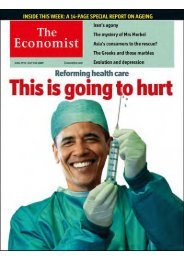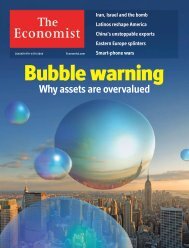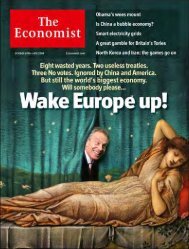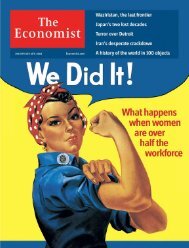Untitled - the ultimate blog
Untitled - the ultimate blog
Untitled - the ultimate blog
Create successful ePaper yourself
Turn your PDF publications into a flip-book with our unique Google optimized e-Paper software.
In an influential early example of this sort of study, Joshua Angrist of <strong>the</strong> Massachusetts Institute of<br />
Technology (MIT) and Alan Krueger of Princeton University used America’s education laws to create an<br />
instrumental variable based on years of schooling. These laws mean that children born earlier in <strong>the</strong> year<br />
are older when <strong>the</strong>y start school than those born later in <strong>the</strong> year, which means <strong>the</strong>y have received less<br />
schooling by <strong>the</strong> time <strong>the</strong>y reach <strong>the</strong> legal leaving-age. Since a child’s birth date is unrelated to intrinsic<br />
ability, it is a good instrument for teasing out schooling’s true effect on wages. Over time, uses of such<br />
instrumental variables have become a standard part of economists’ set of tools. Freakonomics, <strong>the</strong> 2005<br />
bestseller by Steven Levitt and Stephen Dubner, provides a popular treatment of many of <strong>the</strong> techniques.<br />
Mr Levitt’s analysis of crime during American election cycles, when police numbers rise for reasons<br />
unconnected to crime rates, is a celebrated example of an instrumental variable.<br />
Two recent papers—one by James Heckman of Chicago University and Sergio Urzua of Northwestern<br />
University, and ano<strong>the</strong>r by Angus Deaton of Princeton—are sharply critical of this approach. The authors<br />
argue that <strong>the</strong> causal effects that instrumental strategies identify are uninteresting because such<br />
techniques often give answers to narrow questions. The results from <strong>the</strong> quarter-of-birth study, for<br />
example, do not say much about <strong>the</strong> returns from education for college graduates, whose choices were<br />
unlikely to have been affected by when <strong>the</strong>y were legally eligible to drop out of school. According to Mr<br />
Deaton, using such instruments to estimate causal parameters is like choosing to let light “fall where it<br />
may, and <strong>the</strong>n proclaim[ing] that whatever it illuminates is what we were looking for all along.”<br />
IV leagues<br />
This is too harsh. It is no doubt possible to use instrumental variables to estimate effects on uninteresting<br />
subgroups of <strong>the</strong> population. But <strong>the</strong> quarter-of-birth study, for example, shone light on something that<br />
was both interesting and significant. The instrumental variable in this instance allows a clear, credible<br />
estimate of <strong>the</strong> return from extra schooling for those most inclined to drop out from school early. These<br />
are precisely <strong>the</strong> people whom a policy that sought to prolong <strong>the</strong> amount of education would target.<br />
Proponents of instrumental variables also argue that accurate answers to narrower questions are more<br />
useful than unreliable answers to wider questions.<br />
A more legitimate fear is that important questions for which no good instrumental variables can be found<br />
are getting short shrift because of economists’ obsession with solving statistical problems. Mr Deaton says<br />
that instrumental variables encourage economists to avoid “thinking about how and why things work”.<br />
Striking a balance between accuracy of result and importance of issue is tricky. If economists end up<br />
going too far in emphasising accuracy, <strong>the</strong>y may succeed in taking “<strong>the</strong> con out of econometrics”, as Mr<br />
Leamer urged <strong>the</strong>m to—only to leave more pressing questions on <strong>the</strong> shelf.<br />
Links to <strong>the</strong> papers referred to in this article can be found here<br />
Copyright © 2009 The Economist Newspaper and The Economist Group. All rights reserved.<br />
-119-








![[ccebbook.cn]The Economist August 1st 2009 - the ultimate blog](https://img.yumpu.com/28183607/1/190x252/ccebbookcnthe-economist-august-1st-2009-the-ultimate-blog.jpg?quality=85)



![[ccebook.cn]The World in 2010](https://img.yumpu.com/12057568/1/190x249/ccebookcnthe-world-in-2010.jpg?quality=85)
![[ccemagz.com]The Economist October 24th 2009 - the ultimate blog](https://img.yumpu.com/5191885/1/190x252/ccemagzcomthe-economist-october-24th-2009-the-ultimate-blog.jpg?quality=85)